Music
For other uses, see Music (disambiguation).
| Music | |
|---|---|

A painting on an ancient Greek vase depicts a music lesson (c. 510 BCE).
|
|
| Medium | Sound, silence, time |
| Originating culture | Various |
| Originating era | Paleolithic era |
American jazz singer and songwriter Billie Holiday in New York City in 1947.
Bonnie Raitt is an American singer, guitar player and piano player. A winner of ten Grammy awards, she is also noted for her slide guitar playing.
Lydia Canaan is a Lebanese singer-songwriter noted for fusing Middle-Eastern quarter notes and microtones with anglophone rock, innovating a unique style of World Music. In 2015, she was listed in the catalog of the Rock and Roll Hall of Fame and Museum's Library and Archives as the first rock star of the Middle East.
Asha Bhosle is an Indian singer best known as a playback singer in Hindi cinema. In 2011, she was officially acknowledged by the Guinness Book of World Records as the most recorded artist in music history.
Beethoven was an influential composer from the Classical era. This portrait is from 1820.
The Beatles were a four-piece rock band. They are pictured here in 1965, celebrating their Grammy win.
| Performing arts |
|---|
The creation, performance, significance, and even the definition of music vary according to culture and social context. Indeed, throughout history, some new forms or styles of music have been criticized as "not being music", including Beethoven's Grosse Fuge string quartet in 1825,[3] early jazz in the beginning of the 1900s[4] and hardcore punk in the 1980s.[5] There are many types of music, including popular music, traditional music, art music, music written for religious ceremonies and work songs such as chanteys. Music ranges from strictly organized compositions–such as Classical music symphonies from the 1700s and 1800s, through to spontaneously played improvisational music such as jazz, and avant-garde styles of chance-based contemporary music from the 20th and 21st centuries.
Music can be divided into genres (e.g., country music) and genres can be further divided into subgenres (e.g., country blues and pop country are two of the many country subgenres), although the dividing lines and relationships between music genres are often subtle, sometimes open to personal interpretation, and occasionally controversial. For example, it can be hard to draw the line between some early 1980s hard rock and heavy metal. Within the arts, music may be classified as a performing art, a fine art or as an auditory art. Music may be played or sung and heard live at a rock concert or orchestra performance, heard live as part of a dramatic work (a music theater show or opera), or it may be recorded and listened to on a radio, MP3 player, CD player, Smartphone or as film score or TV show.
In many cultures, music is an important part of people's way of life, as it plays a key role in religious rituals, rite of passage ceremonies (e.g., graduation and marriage), social activities (e.g., dancing) and cultural activities ranging from amateur karaoke singing to playing in an amateur funk band or singing in a community choir. People may make music as a hobby, like a teen playing cello in a youth orchestra, or working as a professional musician or singer. The music industry includes the individuals who create new songs and musical pieces (such as songwriters and composers), individuals who perform music (which include orchestra, jazz band and rock band musicians, singers and conductors), individuals who record music (music producers and sound engineers), individuals who organize concert tours, and individuals who sell recordings and sheet music and scores to customers.
Contents
Etymology
In Greek mythology, the nine muses were the inspiration for many creative endeavors, including the arts.
As a form of art or entertainment
Jean-Gabriel Ferlan performing at a 2008 concert at the collège-lycée Saint-François Xavier
Amateur musicians can compose or perform music for their own pleasure, and derive their income elsewhere. Professional musicians are employed by a range of institutions and organisations, including armed forces (in marching bands, concert bands and popular music groups), churches and synagogues, symphony orchestras, broadcasting or film production companies, and music schools. Professional musicians sometimes work as freelancers or session musicians, seeking contracts and engagements in a variety of settings. There are often many links between amateur and professional musicians. Beginning amateur musicians take lessons with professional musicians. In community settings, advanced amateur musicians perform with professional musicians in a variety of ensembles such as community concert bands and community orchestras.
A distinction is often made between music performed for a live audience and music that is performed in a studio so that it can be recorded and distributed through the music retail system or the broadcasting system. However, there are also many cases where a live performance in front of an audience is also recorded and distributed. Live concert recordings are popular in both classical music and in popular music forms such as rock, where illegally taped live concerts are prized by music lovers. In the jam band scene, live, improvised jam sessions are preferred to studio recordings.
Composition
Main article: Musical composition
People composing music in 2013 using electronic keyboards and computers.
French Baroque music composer Michel Richard Delalande (1657–1726), pen in hand.
Even when music is notated relatively precisely, as in classical music, there are many decisions that a performer has to make, because notation does not specify all of the elements of music precisely. The process of deciding how to perform music that has been previously composed and notated is termed "interpretation". Different performers' interpretations of the same work of music can vary widely, in terms of the tempos that are chosen and the playing or singing style or phrasing of the melodies. Composers and songwriters who present their own music are interpreting their songs, just as much as those who perform the music of others. The standard body of choices and techniques present at a given time and a given place is referred to as performance practice, whereas interpretation is generally used to mean the individual choices of a performer.[citation needed]
Although a musical composition often uses musical notation and has a single author, this is not always the case. A work of music can have multiple composers, which often occurs in popular music when a band collaborates to write a song, or in musical theatre, when one person writes the melodies, a second person writes the lyrics, and a third person orchestrates the songs. In some styles of music, such as the blues, a composer/songwriter may create, perform and record new songs or pieces without ever writing them down in music notation. A piece of music can also be composed with words, images, or computer programs that explain or notate how the singer or musician should create musical sounds. Examples range from avant-garde music that uses graphic notation, to text compositions such as Aus den sieben Tagen, to computer programs that select sounds for musical pieces. Music that makes heavy use of randomness and chance is called aleatoric music, and is associated with contemporary composers active in the 20th century, such as John Cage, Morton Feldman, and Witold Lutosławski. A more commonly known example of chance-based music is the sound of wind chimes jingling in a breeze.
The study of composition has traditionally been dominated by examination of methods and practice of Western classical music, but the definition of composition is broad enough the creation of popular music and traditional music songs and instrumental pieces and to include spontaneously improvised works like those of free jazz performers and African percussionists such as Ewe drummers.
Notation
Main article: Musical notation
Sheet music is written representation of music. This is a homorhythmic (i.e., hymn-style) arrangement of a traditional piece entitled "Adeste Fideles", in standard two-staff format for mixed voices.  Play (help·info)
Play (help·info)
Written notation varies with style and period of music. In the 2000s, notated music is produced as sheet music or, for individuals with computer scorewriter programs, as an image on a computer screen. In ancient times, music notation was put onto stone or clay tablets. To perform music from notation, a singer or instrumentalist requires an understanding of the rhythmic and pitch elements embodied in the symbols and the performance practice that is associated with a piece of music or a genre. In genres requiring musical improvisation, the performer often plays from music where only the chord changes and form of the song are written, requiring the performer to have a great understanding of the music's structure, harmony and the styles of a particular genre (e.g., jazz or country music).
In Western art music, the most common types of written notation are scores, which include all the music parts of an ensemble piece, and parts, which are the music notation for the individual performers or singers. In popular music, jazz, and blues, the standard musical notation is the lead sheet, which notates the melody, chords, lyrics (if it is a vocal piece), and structure of the music. Fake books are also used in jazz; they may consist of lead sheets or simply chord charts, which permit rhythm section members to improvise an accompaniment part to jazz songs. Scores and parts are also used in popular music and jazz, particularly in large ensembles such as jazz "big bands." In popular music, guitarists and electric bass players often read music notated in tablature (often abbreviated as "tab"), which indicates the location of the notes to be played on the instrument using a diagram of the guitar or bass fingerboard. Tabulature was also used in the Baroque era to notate music for the lute, a stringed, fretted instrument.
Improvisation
Main article: Musical improvisation
Musical improvisation
is the creation of spontaneous music, often within (or based on) a
pre-existing harmonic framework or chord progression. Improvisation is
the act of instantaneous composition by performers, where compositional
techniques are employed with or without preparation. Improvisation is a
major part of some types of music, such as blues, jazz, and jazz fusion,
in which instrumental performers improvise solos, melody lines and
accompaniment parts. In the Western art music tradition, improvisation
was an important skill during the Baroque era and during the Classical
era. In the Baroque era, performers improvised ornaments and basso continuo keyboard players improvised chord voicings based on figured bass notation. In the Classical era, solo performers and singers improvised virtuoso cadenzas during concerts. However, in the 20th and early 21st century, as "common practice" Western art music
performance became institutionalized in symphony orchestras, opera
houses and ballets, improvisation has played a smaller role. At the same
time, some modern composers have increasingly included improvisation in their creative work. In Indian classical music, improvisation is a core component and an essential criterion of performances.Theory
Main article: Music theory
Music theory encompasses the nature and mechanics of music. It often
involves identifying patterns that govern composers' techniques and
examining the language and notation of music. In a grand sense, music theory distills and analyzes the parameters or elements of music – rhythm, harmony (harmonic function), melody, structure, form, and texture. Broadly, music theory may include any statement, belief, or conception of or about music.[8] People who study these properties are known as music theorists. Some have applied acoustics, human physiology, and psychology to the explanation of how and why music is perceived.Elements of music
Main article: Aspect of music
Music has many different fundamentals or elements. Depending on the
definition of "element" being used, these can include: pitch, beat or
pulse, tempo, rhythm, melody, harmony, texture, style, allocation of
voices, timbre or color, dynamics, expression, articulation, form and
structure. The elements of music feature prominently in the music
curriculums of Australia, UK and USA. All three curriculums identify
pitch, dynamics, timbre and texture as elements, but the other
identified elements of music are far from universally agreed. Below is a
list of the three official versions of the "elements of music":- Australia: pitch, timbre, texture, dynamics and expression, rhythm, form and structure.[9]
- UK: pitch, timbre, texture, dynamics, duration, tempo, structure.[10]
- USA: pitch, timbre, texture, dynamics, rhythm, form, harmony, style/articulation.[11]
The phrase "the elements of music" is used in a number of different contexts. The two most common contexts can be differentiated by describing them as the "rudimentary elements of music" and the "perceptual elements of music".
Rudimentary elements of music
In the 1800s, the phrase "the elements of music" and the phrase "the rudiments of music" were used interchangeably.[13][14] The elements described in these documents refer to aspects of music that are needed in order to become a musician, Recent writers such as Estrella [15] seem to be using the phrase "elements of music" in a similar manner. A definition which most accurately reflects this usage is: "the rudimentary principles of an art, science, etc.: the elements of grammar."[16] The UK's curriculum switch to the "inter-related dimensions of music" seems to be a move back to using the rudimentary elements of music.Perceptual elements of music
Since the emergence of the study of psychoacoustics in the 1930s, most lists of elements of music have related more to how we hear music than how we learn to play it or study it. C.E. Seashore, in his book Psychology of Music,[17] identified four "psychological attributes of sound". These were: "pitch, loudness, time, and timbre" (p. 3). He did not call them the "elements of music" but referred to them as "elemental components" (p. 2). Nonetheless these elemental components link precisely with four of the most common musical elements: "Pitch" and "timbre" match exactly, "loudness" links with dynamics and "time" links with the time-based elements of rhythm, duration and tempo. This usage of the phrase "the elements of music" links more closely with Webster's New 20th Century Dictionary definition of an element as: "a substance which cannot be divided into a simpler form by known methods"[18] and educational institutions' lists of elements align with this list as well.Writers of lists of "rudimentary elements of music" vary their lists depending on their personal priorities. However, in relation to the perceptual elements of music, it should be possible to identify a list of discrete elements which can be independently manipulated to achieve an intended musical effect. It seems at this stage that there is still research to be done in this area.
Analysis of musical styles
Funk places most of its emphasis on rhythm and groove, with entire songs based around a vamp on a single chord. Pictured are the influential funk musicians George Clinton and Parliament Funkadelic in 2006.
Description of elements of music
Pitch and melody
Pitch is an aspect of a sound that we can hear, reflecting whether one musical sound, note or tone is "higher" or "lower" than another musical sound, note or tone. We can talk about the highness or lowness of pitch in the more general sense, such as the way a listener hears a piercingly high piccolo note or whistling tone as higher in pitch than a deep thump of a bass drum. We also talk about pitch in the precise sense associated with musical melodies, basslines and chords. Precise pitch can only be determined in sounds that have a frequency that is clear and stable enough to distinguish from noise. For example, it is much easier for listeners to discern the pitch of a single note played on a piano than to try to discern the pitch of a crash cymbal that is struck.
The melody to the traditional song "Pop Goes the Weasel"  Play (help·info)
Play (help·info)
Harmony and chords
When musicians play three or more different notes at the same time, this creates a chord. In Western music, including classical music, pop music, rock music and many related styles, the most common chords are triads– three notes usually played at the same time. The most commonly used chords are the major chord and the minor chord.
An example of a major chord is the three pitches C, E and G. An example
of a minor chord is the three pitches A, C and E. (Pictured is a guitar player performing a chord on a guitar).
Rhythm
Rhythm is the arrangement of sounds and silences in time. Meter animates time in regular pulse groupings, called measures or bars, which in Western classical, popular and traditional music often group notes in sets of two (e.g., 2/4 time), three (e.g., 3/4 time, also known as Waltz time, or 3/8 time), or four (e.g., 4/4 time). Meters are made easier to hear because songs and pieces often (but not always) place an emphasis on the first beat of each grouping. Notable exceptions exist, such as the backbeat used in much Western pop and rock, in which a song that uses a measure that consists of four beats (called 4/4 time or common time) will have accents on beats two and four, which are typically performed by the drummer on the snare drum, a loud and distinctive-sounding percussion instrument. In pop and rock, the rhythm parts of a song are played by the rhythm section, which includes chord-playing instruments (e.g., electric guitar, acoustic guitar, piano, or other keyboard instruments), a bass instrument (typically electric bass or for some styles such as jazz and bluegrass, double bass) and a drum kit player.Texture
Musical texture is the overall sound of a piece of music or song. The texture of a piece or sing is determined by how the melodic, rhythmic, and harmonic materials are combined in a composition, thus determining the overall nature of the sound in a piece. Texture is often described in regard to the density, or thickness, and range, or width, between lowest and highest pitches, in relative terms as well as more specifically distinguished according to the number of voices, or parts, and the relationship between these voices (see common types below). For example, a thick texture contains many 'layers' of instruments. One of these layers could be a string section, or another brass. The thickness also is affected by the amount and the richness of the instruments. Texture is commonly described according to the number of and relationship between parts or lines of music:- monophony: a single melody (or "tune") with neither instrumental accompaniment nor a harmony part. A mother singing a lullaby to her baby would be an example.
- heterophony: two or more instruments or singers playing/singing the same melody, but with each performer slightly varying the rhythm or speed of the melody or adding different ornaments to the melody. Two bluegrass fiddlers playing the same traditional fiddle tune together will typically each vary the melody a bit and each add different ornaments.
- polyphony: multiple independent melody lines that interweave together, which are sung or played at the same time. Choral music written in the Renaissance music era was typically written in this style. A round, which is a song such as "Row, Row, Row Your Boat", which different groups of singers all start to sing at a different time, is a simple example of polyphony.
- homophony: a clear melody supported by chordal accompaniment. Most Western popular music songs from the 19th century onward are written in this texture.
Timbre or "tone color"
Timbre, sometimes called "color" or "tone color" is the quality or sound of a voice or instrument.[19] Timbre is what makes a particular musical sound different from another, even when they have the same pitch and loudness. For example, a 440 Hz A note sounds different when it is played on oboe, piano, violin or electric guitar. Even if different players of the same instrument play the same note, their notes might sound different due to differences in instrumental technique (e.g., different embouchures), different types of accessories (e.g., mouthpieces for brass players, reeds for oboe and bassoon players) or strings made out of different materials for string players (e.g., gut strings versus steel strings). Even two instrumentalists playing the same note on the same instrument (one after the other) may sound different due to different ways of playing the instrument (e.g., two string players might hold the bow differently).The physical characteristics of sound that determine the perception of timbre include the spectrum, envelope and overtones of a note or musical sound. For electric instruments developed in the 20th century, such as electric guitar, electric bass and electric piano, the performer can also change the tone by adjusting equalizer controls, tone controls on the instrument, and by using electronic effects units such as distortion pedals. The tone of the electric Hammond organ is controlled by adjusting drawbars.
Expression
Singers add expression to the melodies they sing using many methods, including changing the tone of their singing, adding vibrato to certain notes, or emphasizing important words in the lyrics.
Form
In the tenth edition of The Oxford Companion to Music, Percy Scholes defines musical form as "a series of strategies designed to find a successful mean between the opposite extremes of unrelieved repetition and unrelieved alteration."[22] Examples of common forms of Western music include the fugue, the invention, sonata-allegro, canon, strophic, theme and variations, and rondo. Scholes states that European classical music had only six stand-alone forms: simple binary, simple ternary, compound binary, rondo, air with variations, and fugue (although musicologist Alfred Mann emphasized that the fugue is primarily a method of composition that has sometimes taken on certain structural conventions.[23])
Where a piece cannot readily be broken down into sectional units (though it might borrow some form from a poem, story or programme), it is said to be through-composed. Such is often the case with a fantasia, prelude, rhapsody, etude (or study), symphonic poem, Bagatelle, impromptu, etc.[citation needed] Professor Charles Keil classified forms and formal detail as "sectional, developmental, or variational."[24]
- Sectional form
- Strophic form
Main article: Strophic form
This form is defined by its "unrelieved repetition" (AAAA...).- Medley
- Binary form
Main article: Binary form
Binary form in major and minor keys. Each section must be at least three phrases long.[26]
- Ternary form
Main article: Ternary form
This form has three parts. In Western classical music a simple
ternary form has a third section that is a recapitulation of the first (ABA). Often, the first section is repeated (AABA). This approach was popular in the 18th-century operatic aria,[citation needed] and was called da capo (i.e. "repeat from the top") form. Later, it gave rise to the 32-bar song, with the B
section then often referred to as the "middle eight". A song has more
need than a dance of a self-contained form with a beginning and an end
of course.- Rondo form
Main article: Rondo form
This form has a recurring theme alternating with different (usually
contrasting) sections called "episodes". It may be asymmetrical (ABACADAEA) or symmetrical (ABACABA).
A recurring section, especially the main theme, is sometimes more
thoroughly varied, or else one episode may be a "development" of it. A
similar arrangement is the ritornello form of the Baroque concerto grosso. Arch form (ABCBA) resembles a symmetrical rondo without intermediate repetitions of the main theme. It is normally used in a round.- Variational form
Main article: Variation (music)
Variational forms are those in which variation is an important formative element.Theme and Variations: a theme, which in itself can be of any shorter form (binary, ternary, etc.), forms the only "section" and is repeated indefinitely (as in strophic form) but is varied each time (A,B,A,F,Z,A), so as to make a sort of sectional chain form. An important variant of this, much used in 17th-century British music and in the Passacaglia and Chaconne, was that of the ground bass - a repeating bass theme or basso ostinato over and around which the rest of the structure unfolds, often, but not always, spinning polyphonic or contrapuntal threads, or improvising divisions and descants. This is said by Scholes (1977) to be the form par excellence of unaccompanied or accompanied solo instrumental music. The Rondo is often found with sections varied (AA1BA2CA3BA4) or (ABA1CA2B1A).
- Developmental form
Main article: Musical development
Developmental forms are built directly from smaller units, such as motifs. A well-known Classical piece with a motif is Beethoven's fifth symphony,
which starts with three short repeated notes and then a long note. In
Classical pieces that are based on motifs, the motif is usually
combined, varied and worked out in different ways, perhaps having a
symmetrical or arch-like underpinning and a progressive development from
beginning to end. By far the most important developmental form in
Western classical music is Sonata form. This form, also known as sonata form, first movement form, compound binary, ternary and a variety of other names,[example needed]
developed from the binary-formed dance movement described above but is
almost always cast in a greater ternary form having the nominal
subdivisions of Exposition, Development and Recapitulation. Usually, but not always, the "A" parts (Exposition and Recapitulation, respectively) may be subdivided into two or three themes or theme groups which are taken asunder and recombined to form the "B" part (the development) - thus e. g. (AabB[dev. of a and/or b]A1ab1+coda).
This developmental form is generally confined to certain sections of
the piece, as to the middle section of the first movement of a sonata,
though 19th-century composers such as Berlioz, Liszt and Wagner made
valiant efforts to derive large-scale works purely or mainly from the
motif.History
Further information: History of music
Prehistoric eras
Main article: Prehistoric music
A bone flute which is over 41,000 years old.
Ancient Egypt
Main article: Music of Egypt
Asian cultures
Indian women dressed in regional attire playing a variety of musical instruments popular in different parts of India
| Gangubai Hangal Durga |
|---|
See also: Music of Iran, Music of Afghanistan, Music of Tajikistan, Music of Sri Lanka, and Music of Uzbekistan
Indian classical music is one of the oldest musical traditions in the world.[34] The Indus Valley civilization has sculptures that show dance[35]
and old musical instruments, like the seven holed flute. Various types
of stringed instruments and drums have been recovered from Harappa and Mohenjo Daro by excavations carried out by Sir Mortimer Wheeler.[36] The Rigveda has elements of present Indian music, with a musical notation to denote the metre and the mode of chanting.[37] Indian classical music (marga) is monophonic, and based on a single melody line or raga rhythmically organized through talas. Silappadhikaram by Ilango Adigal provides information about how new scales can be formed by modal shifting of the tonic from an existing scale.[38]
Hindustani music was influenced by the Persian performance practices of
the Afghan Mughals. Carnatic music, popular in the southern states, is
largely devotional; the majority of the songs are addressed to the Hindu
deities. There are also many songs emphasising love and other social
issues.Asian music covers the music cultures of Arabia, Central Asia, East Asia, South Asia, and Southeast Asia. Chinese classical music, the traditional art or court music of China, has a history stretching over around three thousand years. It has its own unique systems of musical notation, as well as musical tuning and pitch, musical instruments and styles or musical genres. Chinese music is pentatonic-diatonic, having a scale of twelve notes to an octave (5 + 7 = 12) as does European-influenced music. Persian music is the music of Persia and Persian language countries: musiqi, the science and art of music, and muzik, the sound and performance of music (Sakata 1983).
References in the Bible
Main article: History of music in the biblical period
c. 960, Constantinople
- "While Genesis 4.21 identifies Jubal as the "father of all such as handle the harp and pipe," the Pentateuch is nearly silent about the practice and instruction of music in the early life of Israel. Then, in I Samuel 10 and the texts that follow, a curious thing happens. "One finds in the biblical text," writes Alfred Sendrey, "a sudden and unexplained upsurge of large choirs and orchestras, consisting of thoroughly organized and trained musical groups, which would be virtually inconceivable without lengthy, methodical preparation." This has led some scholars to believe that the prophet Samuel was the patriarch of a school, which taught not only prophets and holy men, but also sacred-rite musicians. This public music school, perhaps the earliest in recorded history, was not restricted to a priestly class—which is how the shepherd boy David appears on the scene as a minstrel to King Saul."[39]
Antiquity
Major ancient Western cultures have had a major influence on the development of music. The history of music in Western cultures can be traced back to Ancient Greek times. Ancient Greek society produced the first Western philosophers, some of whom wrote theories about music. Music was an important part of Ancient Greek culture, and in turn, influenced the Ancient Roman culture.Ancient Greece
Music was an important part of social and cultural life in Ancient Greece. Musicians and singers played a prominent role in Greek theater.[40] Mixed-gender choruses performed for entertainment, celebration, and spiritual ceremonies.[41] Instruments included the double-reed aulos and a plucked string instrument, the lyre, principally the special kind called a kithara. Music was an important part of education, and boys were taught music starting at age six. Greek musical literacy created a flowering of music development. Greek music theory included the Greek musical modes, that eventually became the basis for Western religious and classical music. Later, influences from the Roman Empire, Eastern Europe, and the Byzantine Empire changed Greek music. The Seikilos epitaph is the oldest surviving example of a complete musical composition, including musical notation, from anywhere in the world.The first work written on the subject of music theory is Harmonika Stoicheia.[42]
Middle Ages
| Léonin or Pérotin Breves dies hominis |
|---|
Musical notation from a Catholic Missal, c. 1310–1320
Renaissance
| T.L. de Victoria Amicus meus |
|---|
Allegory of Music, by Filippino Lippi
Baroque
| J.S. Bach Toccata and Fugue |
|---|
Classicism
| W.A. Mozart Symphony 40 g-moll |
|---|
Wolfgang Amadeus Mozart (seated at the keyboard) was a child prodigy virtuoso performer on the piano and violin. Even before he became a celebrated composer, he was widely known as a gifted performer and improviser.
Importance was given to instrumental music. It was dominated by further development of musical forms initially defined in the Baroque period: the sonata, the concerto, and the symphony. Others main kinds were the trio, string quartet, serenade and divertimento. The sonata was the most important and developed form. Although Baroque composers also wrote sonatas, the Classical style of sonata is completely distinct. All of the main instrumental forms of the Classical era, from string quartets to symphonies and concertos, were based on the structure of the sonata. The instruments used chamber music and orchestra became more standardized. In place of the basso continuo group of the Baroque era, which consisted of harpsichord, organ or lute along with a number of bass instruments selected at the discretion of the group leader (e.g., viol, cello, theorbo, serpent), Classical chamber groups used specified, standardized instruments (e.g., a string quartet would be performed by two violins, a viola and a cello). The Baroque era improvised chord-playing of the continuo keyboardist or lute player was gradually phased out between 1750 and 1800.
One of the most important changes made in the Classical period was the development of public concerts. The aristocracy still played a significant role in the sponsorship of concerts and compositions, but it was now possible for composers to survive without being permanent employees of queens or princes. The increasing popularity of classical music led to a growth in the number and types of orchestras. The expansion of orchestral concerts necessitated the building of large public performance spaces. Symphonic music including symphonies, musical accompaniment to ballet and mixed vocal/instrumental genres such as opera and oratorio became more popular.
The best known composers of Classicism are Carl Philipp Emanuel Bach, Christoph Willibald Gluck, Johann Christian Bach, Joseph Haydn, Wolfgang Amadeus Mozart, Ludwig van Beethoven and Franz Schubert. Beethoven and Schubert are also considered to be composers in the later part of the Classical era, as it began to move towards Romanticism.
Romanticism
The piano was the centrepiece of social activity for middle-class urbanites in the 19th century (Moritz von Schwind, 1868). The man at the piano is composer Franz Schubert.
| R. Wagner Die Walküre |
|---|
Romantic composers grew in idiosyncrasy, and went further in the syncretism of exploring different art-forms in a musical context, (such as literature), history (historical figures and legends), or nature itself. Romantic love or longing was a prevalent theme in many works composed during this period. In some cases the formal structures from the classical period continued to be used (e.g., the sonata form used in string quartets and symphonies), but these forms were expanded and altered. In many cases, new approaches were explored for existing genres, forms, and functions. Also, new forms were created that were deemed better suited to the new subject matter. Composers continued to develop opera and ballet music, exploring new styles and themes.[40]
In the years after 1800, the music developed by Ludwig van Beethoven and Franz Schubert introduced a more dramatic, expressive style. In Beethoven's case, short motifs, developed organically, came to replace melody as the most significant compositional unit (an example is the distinctive four note figure used in his Fifth Symphony). Later Romantic composers such as Pyotr Ilyich Tchaikovsky, Antonín Dvořák, and Gustav Mahler used more unusual chords and more dissonance to create dramatic tension. They generated complex and often much longer musical works. During the late Romantic period, composers explored dramatic chromatic alterations of tonality, such as extended chords and altered chords, which created new sound "colours". The late 19th century saw a dramatic expansion in the size of the orchestra, and the industrial revolution helped to create better instruments, creating a more powerful sound. Public concerts became an important part of well-to-do urban society. It also saw a new diversity in theatre music, including operetta, and musical comedy and other forms of musical theatre.[40]
20th- and 21st-century music
Main article: 20th-century music
A jazz group consisting of double bassist Reggie Workman, tenor saxophone player Pharoah Sanders, and drummer Idris Muhammad, performing in 1978
The focus of art music in the 20th century was characterized by exploration of new rhythms, styles, and sounds. The horrors of World War I influenced many of the arts, including music, and some composers began exploring darker, harsher sounds. Traditional music styles such as jazz and folk music were used by composers as a source of ideas for classical music. Igor Stravinsky, Arnold Schoenberg, and John Cage were all influential composers in 20th-century art music. The invention of sound recording and the ability to edit music gave rise to new subgenre of classical music, including the acousmatic[45] and Musique concrète schools of electronic composition. Sound recording was also a major influence on the development of popular music genres, because it enabled recordings of songs and bands to be widely distributed. The introduction of the multitrack recording system had a major influence on rock music, because it could do much more than record a band's performance. Using a multitrack system, a band and their music producer could overdub many layers of instrument tracks and vocals, creating new sounds that would not be possible in a live performance.
Jazz evolved and became an important genre of music over the course of the 20th century, and during the second half of that century, rock music did the same. Jazz is an American musical artform that originated in the beginning of the 20th century in African American communities in the Southern United States from a confluence of African and European music traditions. The style's West African pedigree is evident in its use of blue notes, improvisation, polyrhythms, syncopation, and the swung note.[46] From its early development until the present, jazz has also incorporated music from 19th- and 20th-century American popular music.[47] Jazz has, from its early-20th-century inception, spawned a variety of subgenres, ranging from New Orleans Dixieland (1910s) to 1970s and 1980s-era jazz-rock fusion.
Rock music is a genre of popular music that developed in the 1960s from 1950s rock and roll, rockabilly, blues, and country music.[48] The sound of rock often revolves around the electric guitar or acoustic guitar, and it uses a strong back beat laid down by a rhythm section of electric bass guitar, drums, and keyboard instruments such as organ, piano, or, since the 1970s, analog synthesizers and digital ones and computers since the 1990s. Along with the guitar or keyboards, saxophone and blues-style harmonica are used as soloing instruments. In its "purest form," it "has three chords, a strong, insistent back beat, and a catchy melody."[49] In the late 1960s and early 1970s, it branched out into different subgenres, ranging from blues rock and jazz-rock fusion to heavy metal and punk rock, as well as the more classical influenced genre of progressive rock and several types of experimental rock genres.
Performance
Main article: Performance
Chinese Naxi musicians
A performance can either be planned out and rehearsed (practiced)–which is the norm in classical music, with jazz big bands and many popular music styles–or improvised over a chord progression (a sequence of chords), which is the norm in small jazz and blues groups. Rehearsals of orchestras, concert bands and choirs are led by a conductor. Rock, blues and jazz bands are usually led by the bandleader. A rehearsal is a structured repetition of a song or piece by the performers until it can be sung and/or played correctly and, if it is a song or piece for more than one musician, until the parts are together from a rhythmic and tuning perspective. Improvisation is the creation of a musical idea–a melody or other musical line–created on the spot, often based on scales or pre-existing melodic riffs.
Many cultures have strong traditions of solo performance (in which one singer or instrumentalist performs), such as in Indian classical music, and in the Western art-music tradition. Other cultures, such as in Bali, include strong traditions of group performance. All cultures include a mixture of both, and performance may range from improvised solo playing to highly planned and organised performances such as the modern classical concert, religious processions, classical music festivals or music competitions. Chamber music, which is music for a small ensemble with only a few of each type of instrument, is often seen as more intimate than large symphonic works.
Oral and aural tradition
Many types of music, such as traditional blues and folk music were not written down in sheet music; instead, they were originally preserved in the memory of performers, and the songs were handed down orally, from one musician or singer to another, or aurally, in which a performer learns a song "by ear". When the composer of a song or piece is no longer known, this music is often classified as "traditional" or as a "folk song". Different musical traditions have different attitudes towards how and where to make changes to the original source material, from quite strict, to those that demand improvisation or modification to the music. A culture's history and stories may also be passed on by ear through song.Ornamentation
Main article: Ornament (music)
In the 19th century, art music for solo performers may give a general instruction such as to perform the music expressively, without describing in detail how the performer should do this. The performer was expected to know how to use tempo changes, accentuation, and pauses (among other devices) to obtain this "expressive" performance style. In the 20th century, art music notation often became more explicit and used a range of markings and annotations to indicate to performers how they should play or sing the piece.
In popular music and jazz, music notation almost always indicates only the basic framework of the melody, harmony, or performance approach; musicians and singers are expected to know the performance conventions and styles associated with specific genres and pieces. For example, the "lead sheet" for a jazz tune may only indicate the melody and the chord changes. The performers in the jazz ensemble are expected to know how to "flesh out" this basic structure by adding ornaments, improvised music, and chordal accompaniment.
Philosophy and aesthetics
Main articles: Philosophy of music and Aesthetics of music
A painting by Boldini of a woman playing the piano.
- What is the definition of music? (What are the necessary and sufficient conditions for classifying something as music?)
- What is the relationship between music and mind?
- What does musical history reveal to us about the world?
- What is the connection between music and emotions?
- What is meaning in relation to music?
In the 20th century, important contributions were made by Peter Kivy, Jerrold Levinson, Roger Scruton, and Stephen Davies. However, many musicians, music critics, and other non-philosophers have contributed to the aesthetics of music. In the 19th century, a significant debate arose between Eduard Hanslick, a music critic and musicologist, and composer Richard Wagner regarding whether music can express meaning. Harry Partch and some other musicologists, such as Kyle Gann, have studied and tried to popularize microtonal music and the usage of alternate musical scales. Also many modern composers like La Monte Young, Rhys Chatham and Glenn Branca paid much attention to a scale called just intonation.
It is often thought that music has the ability to affect our emotions, intellect, and psychology; it can assuage our loneliness or incite our passions. The philosopher Plato suggests in the Republic that music has a direct effect on the soul. Therefore, he proposes that in the ideal regime music would be closely regulated by the state. (Book VII)
There has been a strong tendency in the aesthetics of music to emphasize the paramount importance of compositional structure; however, other issues concerning the aesthetics of music include lyricism, harmony, hypnotism, emotiveness, temporal dynamics, resonance, playfulness, and color (see also musical development).
Psychology
Main article: Music psychology
Modern music psychology aims to explain and understand musical behavior and experience.[50] Research in this field and its subfields are primarily empirical; their knowledge tends to advance on the basis of interpretations of data collected by systematic observation of and interaction with human participants.
In addition to its focus on fundamental perceptions and cognitive
processes, music psychology is a field of research with practical
relevance for many areas, including music performance, composition, education, criticism, and therapy, as well as investigations of human aptitude, skill, intelligence, creativity, and social behavior.Cognitive neuroscience of music
Main article: Cognitive neuroscience of music
The primary auditory cortex is one of the main areas associated with superior pitch resolution.
Cognitive musicology
Main article: Cognitive musicology
Cognitive musicology is a branch of cognitive science concerned with computationally modeling musical knowledge with the goal of understanding both music and cognition.[51] The use of computer models provides an exacting, interactive medium in which to formulate and test theories and has roots in artificial intelligence and cognitive science.[52]This interdisciplinary field investigates topics such as the parallels between language and music in the brain. Biologically inspired models of computation are often included in research, such as neural networks and evolutionary programs.[53] This field seeks to model how musical knowledge is represented, stored, perceived, performed, and generated. By using a well-structured computer environment, the systematic structures of these cognitive phenomena can be investigated.[54]
Psychoacoustics
Main article: Psychoacoustics
Further information: Hearing (sense)
Psychoacoustics is the scientific study of sound perception. More specifically, it is the branch of science studying the psychological and physiological responses associated with sound (including speech and music). It can be further categorized as a branch of psychophysics.Evolutionary musicology
Main article: Evolutionary musicology
Evolutionary musicology concerns the "origins of music, the question
of animal song, selection pressures underlying music evolution", and
"music evolution and human evolution".[55] It seeks to understand music perception and activity in the context of evolutionary theory. Charles Darwin speculated that music may have held an adaptive advantage and functioned as a protolanguage,[56] a view which has spawned several competing theories of music evolution.[57][58][59] An alternate view sees music as a by-product of linguistic evolution; a type of "auditory cheesecake" that pleases the senses without providing any adaptive function.[60] This view has been directly countered by numerous music researchers.[61][62][63]Culture in music cognition
Main article: Culture in music cognition
See also: Ethnomusicology
An individual's culture or ethnicity plays a role in their music cognition, including their preferences, emotional reaction, and musical memory.
Musical preferences are biased toward culturally familiar musical
traditions beginning in infancy, and adults' classification of the
emotion of a musical piece depends on both culturally specific and
universal structural features.[64][65]
Additionally, individuals' musical memory abilities are greater for
culturally familiar music than for culturally unfamiliar music.[66][67]Sociological aspects
Main article: Sociomusicology
Other types of music—including, but not limited to, jazz, blues, soul, and country—are often performed in bars, nightclubs, and theatres, where the audience may be able to drink, dance, and express themselves by cheering. Until the later 20th century, the division between "high" and "low" musical forms was widely accepted as a valid distinction that separated out better quality, more advanced "art music" from the popular styles of music heard in bars and dance halls.
However, in the 1980s and 1990s, musicologists studying this perceived divide between "high" and "low" musical genres argued that this distinction is not based on the musical value or quality of the different types of music.[citation needed] Rather, they argued that this distinction was based largely on the socioeconomics standing or social class of the performers or audience of the different types of music.[citation needed] For example, whereas the audience for Classical symphony concerts typically have above-average incomes, the audience for a rap concert in an inner-city area may have below-average incomes.[citation needed] Even though the performers, audience, or venue where non-"art" music is performed may have a lower socioeconomic status, the music that is performed, such as blues, rap, punk, funk, or ska may be very complex and sophisticated.
When composers introduce styles of music that break with convention, there can be a strong resistance from academic music experts and popular culture. Late-period Beethoven string quartets, Stravinsky ballet scores, serialism, bebop-era jazz, hip hop, punk rock, and electronica have all been considered non-music by some critics when they were first introduced.[citation needed] Such themes are examined in the sociology of music. The sociological study of music, sometimes called sociomusicology, is often pursued in departments of sociology, media studies, or music, and is closely related to the field of ethnomusicology.
Role of women
Main article: Women in music
Nineteenth-century composer and pianist Clara Schumann.
Women comprise a significant proportion of instrumental soloists in classical music and the percentage of women in orchestras is increasing. A 2015 article on concerto soloists in major Canadian orchestras, however, indicated that 84% of the soloists with the Orchestre Symphonique de Montreal were men. In 2012, women still made up just 6% of the top-ranked Vienna Philharmonic orchestra. Women are less common as instrumental players in popular music genres such as rock and heavy metal, although there have been a number of notable female instrumentalists and all-female bands. Women are particularly underrepresented in extreme metal genres.[70] In the 1960s pop music scene, "[l]ike most aspects of the...music business, [in the 1960s,] songwriting was a male-dominated field. Though there were plenty of female singers on the radio, women ...were primarily seen as consumers:... Singing was sometimes an acceptable pastime for a girl, but playing an instrument, writing songs, or producing records simply wasn't done."[71] Young women "...were not socialized to see themselves as people who create [music]."[71]
Women are also underrepresented in orchestral conducting, music criticism/music journalism, music producing, and sound engineering. While women were discouraged from composing in the 19th century, and there are few women musicologists, women became involved in music education "...to such a degree that women dominated [this field] during the later half of the 19th century and well into the 20th century."[72]
According to Jessica Duchen, a music writer for London's The Independent, women musicians in classical music are "...too often judged for their appearances, rather than their talent" and they face pressure "...to look sexy onstage and in photos."[73] Duchen states that while "[t]here are women musicians who refuse to play on their looks,...the ones who do tend to be more materially successful."[73] According to the UK's Radio 3 editor, Edwina Wolstencroft, the music industry has long been open to having women in performance or entertainment roles, but women are much less likely to have positions of authority, such as being the leader of an orchestra.[74] In popular music, while there are many women singers recording songs, there are very few women behind the audio console acting as music producers, the individuals who direct and manage the recording process.[75] One of the most recorded artists is Asha Bhosle, an Indian singer best known as a playback singer in Hindi cinema.[citation needed]
Media and technology
Further information: Computer music and Music technology
Music production in the 2000s using a digital audio workstation (DAW) with an electronic keyboard and a multi-monitor set-up.
Technology has had an influence on music since prehistoric times, when cave people used simple tools to bore holes into bone flutes 41,000 years ago. Technology continued to influence music throughout the history of music, as it enabled new instruments and music notation reproduction systems to be used, with one of the watershed moments in music notation being the invention of the printing press in the 1400s, which meant music scores no longer had to be hand copied. In the 19th century, music technology led to the development of a more powerful, louder piano and led to the development of new valves brass instruments. In the early 20th century (in the late 1920s), as talking pictures emerged in the early 20th century, with their prerecorded musical tracks, an increasing number of moviehouse orchestra musicians found themselves out of work.[76] During the 1920s live musical performances by orchestras, pianists, and theater organists were common at first-run theaters.[77] With the coming of the talking motion pictures, those featured performances were largely eliminated. The American Federation of Musicians (AFM) took out newspaper advertisements protesting the replacement of live musicians with mechanical playing devices. One 1929 ad that appeared in the Pittsburgh Press features an image of a can labeled "Canned Music / Big Noise Brand / Guaranteed to Produce No Intellectual or Emotional Reaction Whatever"[78]
Since legislation introduced to help protect performers, composers, publishers and producers, including the Audio Home Recording Act of 1992 in the United States, and the 1979 revised Berne Convention for the Protection of Literary and Artistic Works in the United Kingdom, recordings and live performances have also become more accessible through computers, devices and Internet in a form that is commonly known as Music-On-Demand.
In many cultures, there is less distinction between performing and listening to music, since virtually everyone is involved in some sort of musical activity, often communal. In industrialized countries, listening to music through a recorded form, such as sound recording or watching a music video, became more common than experiencing live performance, roughly in the middle of the 20th century.
Sometimes, live performances incorporate prerecorded sounds. For example, a disc jockey uses disc records for scratching, and some 20th-century works have a solo for an instrument or voice that is performed along with music that is prerecorded onto a tape. Computers and many keyboards can be programmed to produce and play Musical Instrument Digital Interface (MIDI) music. Audiences can also become performers by participating in karaoke, an activity of Japanese origin centered on a device that plays voice-eliminated versions of well-known songs. Most karaoke machines also have video screens that show lyrics to songs being performed; performers can follow the lyrics as they sing over the instrumental tracks.
Internet
YouTube presents pop singer Taylor Swift.
Another effect of the Internet arose with online communities and social media websites like YouTube and Facebook, a social networking service. These sites make it easier for aspiring singers and amateur bands to distribute videos of their songs, connect with other musicians, and gain audience interest. Professional musicians also use YouTube as a free publisher of promotional material. YouTube users, for example, no longer only download and listen to MP3s, but also actively create their own. According to Don Tapscott and Anthony D. Williams, in their book Wikinomics, there has been a shift from a traditional consumer role to what they call a "prosumer" role, a consumer who both creates content and consumes. Manifestations of this in music include the production of mashes, remixes, and music videos by fans.[80]
Business
Main article: Music industry
The music industry refers to the businesses connected with the creation and sale of music. It consists of songwriters and composers who create new songs and musical pieces, music producers and sound engineers who record songs and pieces, record labels and publishers that distribute recorded music products and sheet music internationally and that often control the rights to those products. Some music labels are "independent," while others are subsidiaries of larger corporate entities or international media groups. In the 2000s, the increasing popularity of listening to music as digital music files on MP3 players, iPods, or computers, and of trading music on file sharing
websites or buying it online in the form of digital files had a major
impact on the traditional music business. Many smaller independent CD stores
went out of business as music buyers decreased their purchases of CDs,
and many labels had lower CD sales. Some companies did well with the
change to a digital format, though, such as Apple's iTunes, an online music store that sells digital files of songs over the Internet.Intellectual property laws
Main article: Royalty_payment § Music_royalties
In spite of some international copyright treaties, determining which music is in the public domain is complicated by the variety of national copyright laws that may be applicable. US copyright law formerly protected printed music published after 1923 for 28 years and with renewal for another 28 years, but the Copyright Act of 1976 made renewal automatic, and the Digital Millennium Copyright Act changed the calculation of the copyright term to 70 years after the death of the creator. Recorded sound falls under mechanical licensing, often covered by a confusing patchwork of state laws; most cover versions are licensed through the Harry Fox Agency. Performance rights may be obtained by either performers or the performance venue; the two major organizations for licensing are BMI and ASCAP. Two online sources for public domain music are IMSLP (International Music Score Library Project) and Choral Public Domain Library (CPDL).Education
Non-professional
Main article: Music education
A Suzuki violin recital with students of varying ages.
At the university level, students in most arts and humanities programs can receive credit for taking a few music courses, which typically take the form of an overview course on the history of music, or a music appreciation course that focuses on listening to music and learning about different musical styles. In addition, most North American and European universities have some types of musical ensembles that students in arts and humanities are able to participate in, such as choirs, marching bands, concert bands, or orchestras. The study of Western art music is increasingly common outside of North America and Europe, such as the Indonesian Institute of the Arts in Yogyakarta, Indonesia, or the classical music programs that are available in Asian countries such as South Korea, Japan, and China. At the same time, Western universities and colleges are widening their curriculum to include music of non-Western cultures, such as the music of Africa or Bali (e.g. Gamelan music).
Professional training
Manhattan School of Music professor and professional double bass player Timothy Cobb
teaching a bass lesson in the late 2000s. His bass has a low C
extension with a metal "machine" with buttons for playing the pitches on
the extension.
While most university and conservatory music programs focus on training students in classical music, there are a number of universities and colleges that train musicians for careers as jazz or popular music musicians and composers, with notable U.S. examples including the Manhattan School of Music and the Berklee College of Music. Two important schools in Canada which offer professional jazz training are McGill University and Humber College. Individuals aiming at careers in some types of music, such as heavy metal music, country music or blues are less likely to become professionals by completing degrees or diplomas in colleges or universities. Instead, they typically learn about their style of music by singing and/or playing in many bands (often beginning in amateur bands, cover bands and tribute bands), studying recordings available on CD, DVD and the Internet and working with already-established professionals in their style of music, either through informal mentoring or regular music lessons. Since the 2000s, the increasing popularity and availability of Internet forums and YouTube "how-to" videos have enabled many singers and musicians from metal, blues and similar genres to improve their skills. Many pop, rock and country singers train informally with vocal coaches and singing teachers.
Undergraduate
Undergraduate university degrees in music, including the Bachelor of Music, the Bachelor of Music Education, and the Bachelor of Arts (with a major in music) typically take about four years to complete. These degrees provide students with a grounding in music theory and music history, and many students also study an instrument or learn singing technique as part of their program. Graduates of undergraduate music programs can seek employment or go on to further study in music graduate programs. Bachelor's degree graduates are also eligible to apply to some graduate programs and professional schools outside of music (e.g., public administration, business administration, library science, and, in some jurisdictions, teacher's college, law school or medical school).Graduate
Graduate music degrees include the Master of Music, the Master of Arts, the Doctor of Philosophy (Ph.D.) (e.g., in musicology or music theory), and more recently, the Doctor of Musical Arts, or DMA. The Master of Music degree, which takes one to two years to complete, is typically awarded to students studying the performance of an instrument, education, voice (singing) or composition. The Master of Arts degree, which takes one to two years to complete and often requires a thesis, is typically awarded to students studying musicology, music history, music theory or ethnomusicology.The PhD, which is required for students who want to work as university professors in musicology, music history, or music theory, takes three to five years of study after the master's degree, during which time the student will complete advanced courses and undertake research for a dissertation. The DMA is a relatively new degree that was created to provide a credential for professional performers or composers that want to work as university professors in musical performance or composition. The DMA takes three to five years after a master's degree, and includes advanced courses, projects, and performances. In Medieval times, the study of music was one of the Quadrivium of the seven Liberal Arts and considered vital to higher learning. Within the quantitative Quadrivium, music, or more accurately harmonics, was the study of rational proportions.
Musicology
Musicology, the academic study of the subject of music, is studied in universities and music conservatories. The earliest definitions from the 19th century defined three sub-disciplines of musicology: systematic musicology, historical musicology, and comparative musicology or ethnomusicology. In 2010-era scholarship, one is more likely to encounter a division of the discipline into music theory, music history, and ethnomusicology. Research in musicology has often been enriched by cross-disciplinary work, for example in the field of psychoacoustics. The study of music of non-Western cultures, and the cultural study of music, is called ethnomusicology. Students can pursue the undergraduate study of musicology, ethnomusicology, music history, and music theory through several different types of degrees, including bachelor's degrees, master's degrees and PhD degrees.Music theory
Music theory is the study of music, generally in a highly technical manner outside of other disciplines. More broadly it refers to any study of music, usually related in some form with compositional concerns, and may include mathematics, physics, and anthropology. What is most commonly taught in beginning music theory classes are guidelines to write in the style of the common practice period, or tonal music. Theory, even of music of the common practice period, may take many other forms. Musical set theory is the application of mathematical set theory to music, first applied to atonal music. Speculative music theory, contrasted with analytic music theory, is devoted to the analysis and synthesis of music materials, for example tuning systems, generally as preparation for composition.Zoomusicology
Zoomusicology is the study of the music of non-human animals, or the musical aspects of sounds produced by non-human animals. As George Herzog (1941) asked, "do animals have music?" François-Bernard Mâche's Musique, mythe, nature, ou les Dauphins d'Arion (1983), a study of "ornitho-musicology" using a technique of Nicolas Ruwet's Langage, musique, poésie (1972) paradigmatic segmentation analysis, shows that bird songs are organised according to a repetition-transformation principle. Jean-Jacques Nattiez (1990), argues that "in the last analysis, it is a human being who decides what is and is not musical, even when the sound is not of human origin. If we acknowledge that sound is not organised and conceptualised (that is, made to form music) merely by its producer, but by the mind that perceives it, then music is uniquely human."Ethnomusicology
Main article: Ethnomusicology
Ethnomusicologist Frances Densmore recording Blackfoot chief Mountain Chief for the Bureau of American Ethnology (1916)
There is a host of music classifications for non-Western music, many of which are caught up in the argument over the definition of music. Among the largest of these is the division between classical music (or "art" music), and popular music (or commercial music – including non-Western styles of rock, country, and pop music-related styles). Some genres do not fit neatly into one of these "big two" classifications, (such as folk music, world music, or jazz-related music).
As world cultures have come into greater global contact, their indigenous musical styles have often merged with other styles, which produces new styles. For example, the United States bluegrass style contains elements from Anglo-Irish, Scottish, Irish, German and African instrumental and vocal traditions, which were able to fuse in the United States' multi-ethnic "melting pot" society. Some types of world music contain a mixture of non-Western indigenous styles with Western pop music elements. Genres of music are determined as much by tradition and presentation as by the actual music. Some works, like George Gershwin's Rhapsody in Blue, are claimed by both jazz and classical music, while Gershwin's Porgy and Bess and Leonard Bernstein's West Side Story are claimed by both opera and the Broadway musical tradition. Many current music festivals for non-Western music include bands and singers from a particular musical genre, such as world music.
Indian music, for example, is one of the oldest and longest living types of music, and is still widely heard and performed in South Asia, as well as internationally (especially since the 1960s). Indian music has mainly three forms of classical music, Hindustani, Carnatic, and Dhrupad styles. It has also a large repertoire of styles, which involve only percussion music such as the talavadya performances famous in South India.
 |
|
| Problems playing this file? See media help. | |
Music therapy
Main article: Music therapy
A music therapist from a "Blues in the Schools" program plays harmonica with a US Navy sailor at a Naval Therapy Center.
One of the earliest mentions of music therapy was in Al-Farabi's (c. 872 – 950) treatise Meanings of the Intellect, which described the therapeutic effects of music on the soul.[82][verification needed] Music has long been used to help people deal with their emotions. In the 17th century, the scholar Robert Burton's The Anatomy of Melancholy argued that music and dance were critical in treating mental illness, especially melancholia.[83] He noted that music has an "excellent power ...to expel many other diseases" and he called it "a sovereign remedy against despair and melancholy." He pointed out that in Antiquity, Canus, a Rhodian fiddler, used music to "make a melancholy man merry, ...a lover more enamoured, a religious man more devout."[84][85][86] In November 2006, Dr. Michael J. Crawford[87] and his colleagues also found that music therapy helped schizophrenic patients.[88] In the Ottoman Empire, mental illnesses were treated with music.[89]
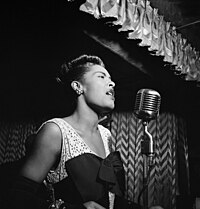





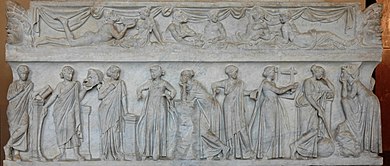




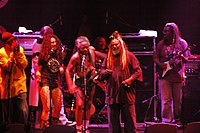











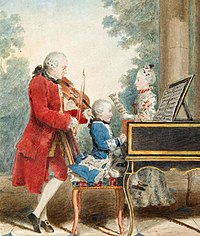
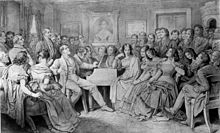
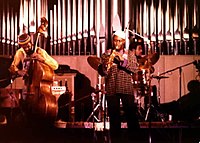

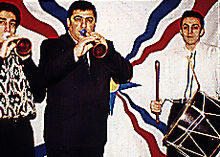

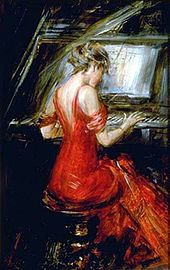






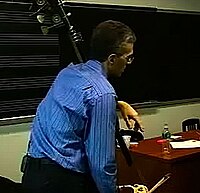

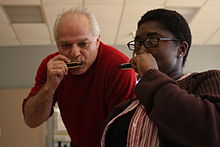
No comments:
Post a Comment